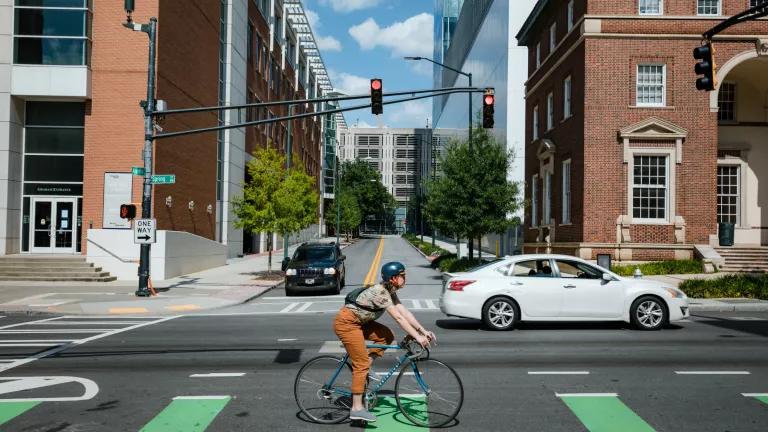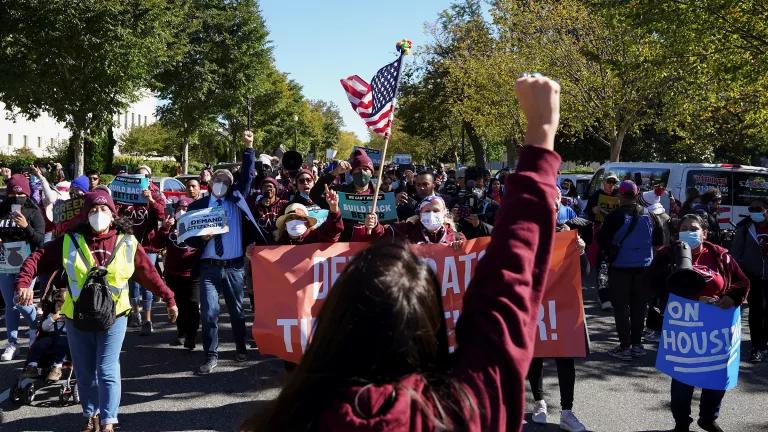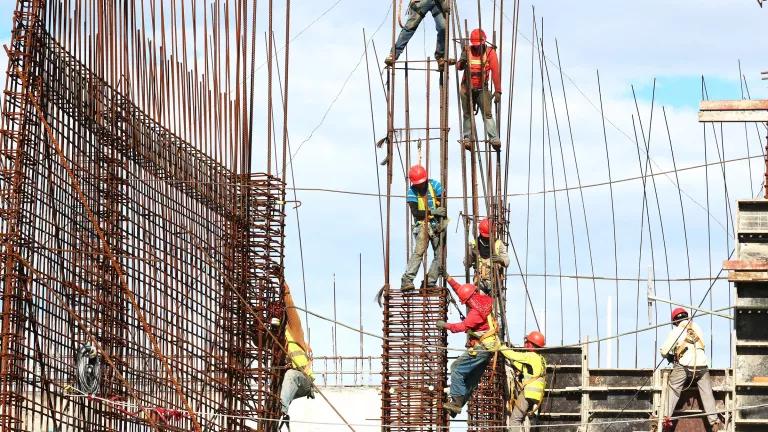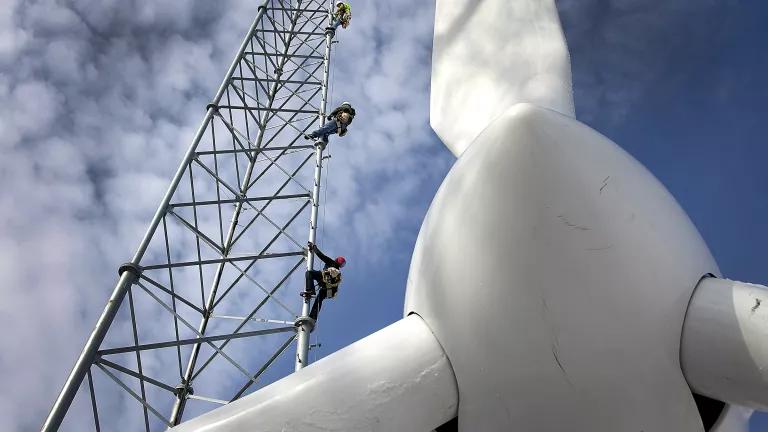25 Cities Demonstrate How Major Climate Wins Are Possible
Cities account for an overwhelmingly large percentage of global carbon emissions, primarily through transportation and buildings. But 25 cities, empowered by the Bloomberg Philanthropies American Cities Climate Challenge, found that when they teamed up together, they could make real strides in the fight against climate change.

A person riding a bicycle in a dedicated bike lane on Spring St in Atlanta, Georgia, on June 23, 2021
Dustin Chambers for NRDC
Despite the numerous environmental obstacles thrown up by the previous administration, many U.S. cities have not only persevered in their efforts to combat climate change but they have made major strides forward, thanks to Bloomberg Philanthropies and its groundbreaking American Cities Climate Challenge program.
Created in 2018, the Climate Challenge, in partnership with NRDC, provided 25 cities with powerful resources to boost their efforts to tackle the climate crisis. Cities account for an overwhelmingly large percentage of global carbon emissions, primarily through transportation and buildings—sectors where mayors can enact real change.
Empowered by the Climate Challenge, these 25 cities implemented 54 major transportation, buildings, and energy policies and 71 bold climate programs and initiatives—even in the midst of a global pandemic—resulting in substantial gains over just two-and-a-half years. In a report that crunched the numbers, here’s what these impressive gains mean in cold, hard data: collectively, the work of the Climate Challenge across these cities will reduce CO2 emissions by 74 million metric tons (MT) from 2020 through 2030, compared to a business-as-usual scenario. When we took this a step further and evaluated their combined achievements, including action taken outside of the Climate Challenge, we found that the cities are on track to collectively reduce emissions by 32 percent below 2005 levels by 2025, which will beat the 2025 Paris Agreement goal of a 26 to 28 percent reduction.
Transforming Transportation
Since transportation generates a significant share of emissions in the United States at 29 percent, Climate Challenge cities made cutting these emissions a priority. To date, they’ve approved 31 policies and launched 41 programs that have incentivized low-carbon transit, increased vehicle electrification, and changed the face of their streets—with 510 miles of new or improved bike lanes and 75 miles of pedestrian-friendly walkways.
To reduce traffic congestion and the emissions that it produces, multiple cities raised new revenue for mass transit to help residents move around without getting into their cars. San Antonio’s innovative Proposition A reallocates one-eighth of every cent of an already existing sales tax to fund nearly $40 million toward cleaner, more efficient public transit. Hamilton County voters in Cincinnati passed Issue 7 to add eight new bus routes and provide 24-hour service in seven major corridors. Overall, Climate Challenge cities added or enhanced 37 miles of bus lanes, among other transit projects. And half a dozen cities launched affordable car-sharing initiatives as an alternative to car ownership.
Moreover, it’s clear that the future of transportation is electric, so with that in mind, several cities implemented electric vehicle (EV) readiness ordinances, accelerated electrification in municipal fleets for a total of 1,136 new EV buses and cars, and installed 14,143 new EV chargers. Many cities plan to convert to fully EV fleets in the coming years.
Boosting Energy Efficiency
Commercial and residential buildings, together with the electricity generated from fossil fuel sources, account for a whopping 38 percent of CO2 emissions in the United States. Climate Challenge cities tackled these interconnected sectors by focusing on increasing energy efficiency and sourcing renewable energy. In total, the cities passed 23 policies and launched 30 programs in the buildings and energy sectors.
More than 37,000 energy audits were conducted to assess current usage and efficiency in buildings. Several cities instituted benchmarking policies—covering nearly 400 million square feet of real estate—in concert with building performance standards that set targets for increasing energy efficiency and reducing emissions progressively, over time.
Nearly half of the cities were able to obtain clean energy sources to power their buildings, with more than 800 megawatts of renewable energy under contract or pending. In New Mexico, the partnership between a soon-to-be-built solar farm on the Jicarilla Apache Nation reservation and the city of Albuquerque will raise the city’s renewable energy usage to an estimated 65 percent. To ensure sustainability into the future, three cities passed reach codes (standards for energy savings beyond current state requirements) that incorporate EV charging, solar, and other renewable energy readiness into new-construction buildings.

Trane employees Christopher Pistolis (left) and Earnell Newman carry their tools as they make their way to a HVAC unit. Pistolis and Newman are just one example of city workforce-development programs.
Logan Cyrus for NRDC
Centering Equity
A citywide climate plan can’t be comprehensive without also addressing the needs of underserved communities, which often bear the brunt of polluting industry and have less access to public transit and clean energy options.
Multiple Climate Challenge cities expanded or added bus routes to better serve these vulnerable communities. Some cities with car-sharing programs made sure to install EV charging stations in underserved neighborhoods and/or offer pricing incentives for seniors and low-income residents to access car-sharing options.
Cincinnati’s WarmUp Cincy program assisted low-income tenants with in-unit energy equipment upgrades to reduce emissions in rental buildings. And in partnership with the Climate Challenge and the city of Orlando, Florida, the Solar and Energy Loan Fund (SELF) empowers underserved homeowners to afford solar and other energy-efficient home improvements to amplify the city’s overall resilience against climate change.
To help build more robust, equitable economies, a handful of Climate Challenge cities and their partners introduced green workforce-development programs as part of their clean energy requirements. More than 800 residents so far have been trained or upskilled to work in high-road clean energy jobs. And, if approved by Congress, President Biden’s Build Back Better Agenda will further bolster these efforts toward an equitable economic recovery for the country.
Looking Forward
As the Climate Challenge has demonstrated, cities can have an outsize impact on climate change and improve people’s lives in a substantive way. With a new administration that’s committed to combating the crisis, federal and state governments can now draw on the leading-edge policies and programs that have been test-driven at the local level. And the 25 pioneering cities that embarked on the Climate Challenge will continue to demonstrate how cities can be leaders and drive momentum at all levels of climate action.



